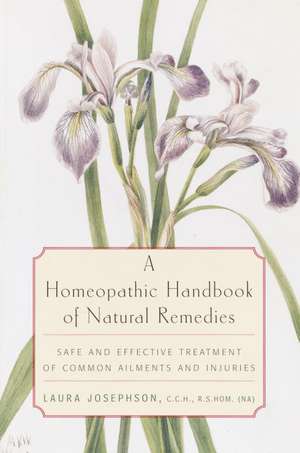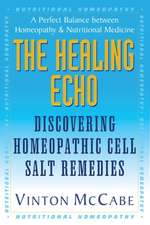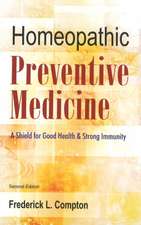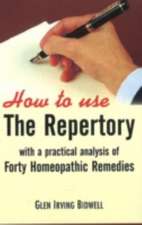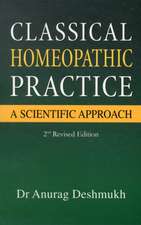A Homeopathic Handbook of Natural Remedies: Safe and Effective Treatment of Common Ailments and Injuries
Autor Laura Josephsonen Limba Engleză Paperback – 31 iul 2002
In addition to homeopathic first aid treatment for such ailments as back pain, puncture wounds, eye injuries, fractures, and insect bites, the book outlines remedies for a wide range of everyday complaints, including allergies, coughs, colds, flu, fevers, digestive problems, headaches, PMS, earaches, insomnia, jet lag, and more. A separate section deals specifically with childhood conditions.
Also included is an extensive resource directory of homeopathic pharmacies and a list of articles and other publications that provide further information.
Preț: 135.05 lei
Nou
Puncte Express: 203
Preț estimativ în valută:
25.85€ • 26.88$ • 21.34£
25.85€ • 26.88$ • 21.34£
Carte disponibilă
Livrare economică 25 martie-08 aprilie
Preluare comenzi: 021 569.72.76
Specificații
ISBN-13: 9780812991888
ISBN-10: 0812991885
Pagini: 354
Dimensiuni: 157 x 236 x 20 mm
Greutate: 0.52 kg
Editura: Villard Books
ISBN-10: 0812991885
Pagini: 354
Dimensiuni: 157 x 236 x 20 mm
Greutate: 0.52 kg
Editura: Villard Books
Notă biografică
Laura Josephson, C.C.H., R.S.Hom. (NA) has been in homeopathic practice since 1992. She is currently the president of the New York State Homeopathic Association. Her interest in homeopathy grew out of her study of herbology and hermetic science. She has studied at the New York School of Homeopathy, the Atlantic Academy of Classical Homeopathy, the New England School of Homeopathy, and with various leaders in the field from around the world. A native of Northern California, she maintains a private practice in Rockland County, New York, where she lives with her husband, four daughters, and a menagerie of dogs, cats, and birds.
Extras
Chapter One
HISTORY AND GUIDING PRINCIPLES
A man could not be born alive and healthy were there not already a physician in him.
-Paracelsus
The softest things in the world overcome the hardest things in the world.
-Lao-tzu
How remarkable it is that when we have a cut or wound on the skin, our inner healing forces immediately rally to defend against infection, create a protective scab, and heal the tissues beneath it. We have all experienced this simple fact, yet it is amazing that our bodies accomplish this without any conscious effort on our part. Every human being is endowed with inherent self-healing resources capable of meeting a wide spectrum of physical, emotional, and mental stresses. Homeopathy recognizes this inner physician working ceaselessly to maintain health and balance in body, soul, and mind.
Homeopathy is a safe and effective system of medicine that helps to restore health by stimulating the body¹s inherent ability to heal itself. This process is activated by giving medicines made from substances found in the animal, vegetable, and mineral kingdoms. Each medicine, or remedy, is selected for its similarity to a sick person¹s unique symptoms of illness or suffering. The word homeopathy is from the Greek: for ³similar² (homoios) and ³suffering² (pathos).
A wide range of conditions can be successfully treated with homeopathy: acute illnesses and infections, injuries, chronic diseases, and mental or emotional disorders. Whether in minor illness or in deeper disease, homeopathy recognizes that all symptoms of ill health are expressions of a disharmony within the whole person, and that it is the person who needs treatment, not the disease. Symptoms are seen not as the illness itself but as healthy signs that our defenses are managing an inner imbalance in the best possible manner under the circumstances. When given appropriately a homeopathic remedy has the power to gently restore health and vitality on all levels: physically, emotionally, and mentally.
HAHNEMANN AND THE LAW OF SIMILARS
In the late 1700s a German physician named Samuel Hahnemann (17551843) developed the medical science and art known as homeopathy. Like Hippocrates two thousand years earlier, Hahnemann recognized two methods of treating illness: one by way of opposites and the other, preferred method, by way of similars. The conventional medical system of today, called allopathy or allopathic medicine, treats by way of opposites.
The fundamental law upon which homeopathy is based is the law of similars, which states: Let likes be cured with likes, in Latin: Similia similibus curentur. This means that a remedy can cure a disease if it produces in a healthy person symptoms similar to those of the sick person. Therefore, homeopathic treatment involves giving a sick person a substance that would cause the very same symptoms of illness in a healthy person.
For example, we all know that slicing onions can result in burning, watery eyes and a runny nose; but when red onion is given as the homeopathic remedy known as Allium cepa, it is curative for people who suffer from hay fever or common colds and share those particular symptoms. Likewise, we know that drinking too much coffee can cause a person to feel restless, nervous, overstimulated, and unable to sleep; but a homeopathic dose of Coffea cruda is curative for people with insomnia and other nervous conditions that share these characteristics. Hahnemann would nod in agreement with the spirit of the adage, ³Take a hair of the dog that bit you.²
Hahnemann was the first in modern times to test the law of similars and create from it a scientific method of treating illness. However, he did not claim to have discovered this concept. The law of similars has roots that can be traced to the cultures of ancient India, China, and Greece. In 400 b.c., Hippocrates described this natural law: ³Through the like, disease is produced, and through the application of the like, disease is cured.² Paracelsus, the sixteenth-century German physician whose writings would later influence Hahnemann, described this principle as well.
Hahnemann did not come by this knowledge without considerable personal and professional trials. He had been a highly respected physician and author of texts on chemistry when, despite his accomplishments, he felt increasingly disturbed by the brutal medical practices of his time. Bloodletting, purging, and toxic doses of mercury and arsenic were popular treatments. His conscience would not allow him to remain silent, and he became an outspoken critic of the system that he thought did more harm than good. His colleagues were quick to denounce him as a medical heretic, and as his frustration grew he eventually withdrew from the practice of medicine. To support his growing family he turned to translating medical treatises. However, he remained faithful to his hope of discovering ³if God had not indeed given some law . . . whereby the diseases of mankind would be cured.²
While working on the translation of a medical text by William Cullen, a renowned Scottish professor of medicine, Hahnemann stumbled upon an assertion that was to become the key to fulfilling his hope. Cullen claimed that cinchona bark, or quinine, was an effective cure for malaria because of its bitter and astringent qualities. Hahnemann was astonished and doubtful of this because he knew of many equally bitter substances that did not cure malaria. But he felt compelled to investigate Cullen¹s assertion and, in the true spirit of scientific inquiry, decided to test the effects of cinchona bark on himself. After taking successive small doses of the substance, he developed a reaction: his array of symptoms was strikingly similar to those of malaria. Hahnemann deduced that the curative power of cinchona bark lay not in its bitter qualities but in its ability to create the symptoms of malaria in a healthy person. This experiment was the first homeopathic proving.
PROVINGS
Hahnemann continued to research other substances in the same manner. A circle of friends, followers, and colleagues grew around him, and with their assistance he went on to establish a comprehensive program of testing potentially curative substances on healthy volunteers. This process is called a proving. Amid the gathering momentum he also found himself once again practicing medicine, now applying the law of similars to treating the sick.
In the provings of Hahnemann¹s time as well as those of today, a group of healthy people is given extremely small doses of a single substance over a period of days until symptoms unlike their normal states develop. Each person carefully records in detail symptoms he or she experiences. All the provers¹ symptoms are then gathered together to form a remedy picture. This list represents the most consistently experienced range of symptoms from among the provers, ³as if one person.² By this method the medicinal effect of a substance can be determined for therapeutic use.
Information from provings is then gathered with data from toxicological reports and accidental poisonings when applicable. The combined data is entered into a reference book called a materia medica (Latin for ³materials of medicine²). Referred to by all homeopaths, the materia medica lists all the homeopathic remedies in use. It describes in detail the mental, emotional, and physical symptoms associated with each medicinal substance.
At the time of Hahnemann¹s death in 1843, he had completed provings of ninety-nine substances and written six editions of the Organon, his guidebook for the use of homeopathic remedies. By the end of the nineteenth century, over six hundred more remedies were added to the list of proven medicines. Today there are over thirteen hundred remedies registered in the Homeopathic Pharmacopoea of the United States.
THE MINIMUM DOSE
Hahnemann firmly believed in the importance of using only the minimum amount of a medicine to effect a cure. He called this the principle of the minimum dose. Since human beings are by nature endowed with strong healing forces, Hahnemann thought that only a small stimulus should be necessary to begin the process of cure.
Giving the smallest dose of a remedy acts as a catalyst to a person¹s own defenses. Once the healing action has begun, the process is allowed to continue on its own to ³overcome and destroy the existing disease without further ado,² as Hahnemann put it. That is, without giving any more medicine than is necessary. The same remedy may be repeated on an ³as needed² basis depending on the vitality of the person, the nature of the illness, and the individual¹s overall response to each previous dose. The guiding principle is: Always give the least amount of medicine required for healing. A person may expect to end the course of medication upon feeling well, without having to ³finish the bottle.² In this we see the ideal of restoring health without a perpetual dependency on taking medicine.
THE SINGLE REMEDY
The use of one single remedy at a time is another basic principle and is the hallmark of what is called classical homeopathy. Contrary to the common convention of taking two or more medicines at a time, a person does not need to take one homeopathic remedy for headache, a different one for gas, and yet another for anxiety because, as mentioned earlier, it is the person and not the disease that is to be cured. Though a person may have any number of mental, emotional, and physical symptoms, that person has only one disease: his or her own singular susceptibility and disharmony. Therefore there will be only one remedy picture that will most closely match the overall symptom picture of the person.
TOTALITY OF SYMPTOMS
As stated earlier, a single remedy is selected to match closely a person¹s whole symptom picture, called the totality of symptoms. It is essential to take this totality into account in order to select the most effective remedy. This totality includes not only the obvious symptoms of the chief complaint but a variety of other characteristics as well. Even symptoms that may seem small or unrelated to the main complaint can be crucial to the ultimate choice of remedy, because they can point to a person¹s underlying susceptibility or other critical factors.
Indeed the word symptom can be defined as any perceptible change in the mental, emotional, and physical well-being of a person. For example, changes in appetite and thirst, sensitivity to heat and cold, energy level, sleep and dreams, peculiar sensations, temperament, and mood all may contribute to the totality of symptoms. Part 2 includes a more extensive explanation of symptoms. Thus, the totality is the broadest possible view of the ill person¹s symptoms.
HISTORY AND GUIDING PRINCIPLES
A man could not be born alive and healthy were there not already a physician in him.
-Paracelsus
The softest things in the world overcome the hardest things in the world.
-Lao-tzu
How remarkable it is that when we have a cut or wound on the skin, our inner healing forces immediately rally to defend against infection, create a protective scab, and heal the tissues beneath it. We have all experienced this simple fact, yet it is amazing that our bodies accomplish this without any conscious effort on our part. Every human being is endowed with inherent self-healing resources capable of meeting a wide spectrum of physical, emotional, and mental stresses. Homeopathy recognizes this inner physician working ceaselessly to maintain health and balance in body, soul, and mind.
Homeopathy is a safe and effective system of medicine that helps to restore health by stimulating the body¹s inherent ability to heal itself. This process is activated by giving medicines made from substances found in the animal, vegetable, and mineral kingdoms. Each medicine, or remedy, is selected for its similarity to a sick person¹s unique symptoms of illness or suffering. The word homeopathy is from the Greek: for ³similar² (homoios) and ³suffering² (pathos).
A wide range of conditions can be successfully treated with homeopathy: acute illnesses and infections, injuries, chronic diseases, and mental or emotional disorders. Whether in minor illness or in deeper disease, homeopathy recognizes that all symptoms of ill health are expressions of a disharmony within the whole person, and that it is the person who needs treatment, not the disease. Symptoms are seen not as the illness itself but as healthy signs that our defenses are managing an inner imbalance in the best possible manner under the circumstances. When given appropriately a homeopathic remedy has the power to gently restore health and vitality on all levels: physically, emotionally, and mentally.
HAHNEMANN AND THE LAW OF SIMILARS
In the late 1700s a German physician named Samuel Hahnemann (17551843) developed the medical science and art known as homeopathy. Like Hippocrates two thousand years earlier, Hahnemann recognized two methods of treating illness: one by way of opposites and the other, preferred method, by way of similars. The conventional medical system of today, called allopathy or allopathic medicine, treats by way of opposites.
The fundamental law upon which homeopathy is based is the law of similars, which states: Let likes be cured with likes, in Latin: Similia similibus curentur. This means that a remedy can cure a disease if it produces in a healthy person symptoms similar to those of the sick person. Therefore, homeopathic treatment involves giving a sick person a substance that would cause the very same symptoms of illness in a healthy person.
For example, we all know that slicing onions can result in burning, watery eyes and a runny nose; but when red onion is given as the homeopathic remedy known as Allium cepa, it is curative for people who suffer from hay fever or common colds and share those particular symptoms. Likewise, we know that drinking too much coffee can cause a person to feel restless, nervous, overstimulated, and unable to sleep; but a homeopathic dose of Coffea cruda is curative for people with insomnia and other nervous conditions that share these characteristics. Hahnemann would nod in agreement with the spirit of the adage, ³Take a hair of the dog that bit you.²
Hahnemann was the first in modern times to test the law of similars and create from it a scientific method of treating illness. However, he did not claim to have discovered this concept. The law of similars has roots that can be traced to the cultures of ancient India, China, and Greece. In 400 b.c., Hippocrates described this natural law: ³Through the like, disease is produced, and through the application of the like, disease is cured.² Paracelsus, the sixteenth-century German physician whose writings would later influence Hahnemann, described this principle as well.
Hahnemann did not come by this knowledge without considerable personal and professional trials. He had been a highly respected physician and author of texts on chemistry when, despite his accomplishments, he felt increasingly disturbed by the brutal medical practices of his time. Bloodletting, purging, and toxic doses of mercury and arsenic were popular treatments. His conscience would not allow him to remain silent, and he became an outspoken critic of the system that he thought did more harm than good. His colleagues were quick to denounce him as a medical heretic, and as his frustration grew he eventually withdrew from the practice of medicine. To support his growing family he turned to translating medical treatises. However, he remained faithful to his hope of discovering ³if God had not indeed given some law . . . whereby the diseases of mankind would be cured.²
While working on the translation of a medical text by William Cullen, a renowned Scottish professor of medicine, Hahnemann stumbled upon an assertion that was to become the key to fulfilling his hope. Cullen claimed that cinchona bark, or quinine, was an effective cure for malaria because of its bitter and astringent qualities. Hahnemann was astonished and doubtful of this because he knew of many equally bitter substances that did not cure malaria. But he felt compelled to investigate Cullen¹s assertion and, in the true spirit of scientific inquiry, decided to test the effects of cinchona bark on himself. After taking successive small doses of the substance, he developed a reaction: his array of symptoms was strikingly similar to those of malaria. Hahnemann deduced that the curative power of cinchona bark lay not in its bitter qualities but in its ability to create the symptoms of malaria in a healthy person. This experiment was the first homeopathic proving.
PROVINGS
Hahnemann continued to research other substances in the same manner. A circle of friends, followers, and colleagues grew around him, and with their assistance he went on to establish a comprehensive program of testing potentially curative substances on healthy volunteers. This process is called a proving. Amid the gathering momentum he also found himself once again practicing medicine, now applying the law of similars to treating the sick.
In the provings of Hahnemann¹s time as well as those of today, a group of healthy people is given extremely small doses of a single substance over a period of days until symptoms unlike their normal states develop. Each person carefully records in detail symptoms he or she experiences. All the provers¹ symptoms are then gathered together to form a remedy picture. This list represents the most consistently experienced range of symptoms from among the provers, ³as if one person.² By this method the medicinal effect of a substance can be determined for therapeutic use.
Information from provings is then gathered with data from toxicological reports and accidental poisonings when applicable. The combined data is entered into a reference book called a materia medica (Latin for ³materials of medicine²). Referred to by all homeopaths, the materia medica lists all the homeopathic remedies in use. It describes in detail the mental, emotional, and physical symptoms associated with each medicinal substance.
At the time of Hahnemann¹s death in 1843, he had completed provings of ninety-nine substances and written six editions of the Organon, his guidebook for the use of homeopathic remedies. By the end of the nineteenth century, over six hundred more remedies were added to the list of proven medicines. Today there are over thirteen hundred remedies registered in the Homeopathic Pharmacopoea of the United States.
THE MINIMUM DOSE
Hahnemann firmly believed in the importance of using only the minimum amount of a medicine to effect a cure. He called this the principle of the minimum dose. Since human beings are by nature endowed with strong healing forces, Hahnemann thought that only a small stimulus should be necessary to begin the process of cure.
Giving the smallest dose of a remedy acts as a catalyst to a person¹s own defenses. Once the healing action has begun, the process is allowed to continue on its own to ³overcome and destroy the existing disease without further ado,² as Hahnemann put it. That is, without giving any more medicine than is necessary. The same remedy may be repeated on an ³as needed² basis depending on the vitality of the person, the nature of the illness, and the individual¹s overall response to each previous dose. The guiding principle is: Always give the least amount of medicine required for healing. A person may expect to end the course of medication upon feeling well, without having to ³finish the bottle.² In this we see the ideal of restoring health without a perpetual dependency on taking medicine.
THE SINGLE REMEDY
The use of one single remedy at a time is another basic principle and is the hallmark of what is called classical homeopathy. Contrary to the common convention of taking two or more medicines at a time, a person does not need to take one homeopathic remedy for headache, a different one for gas, and yet another for anxiety because, as mentioned earlier, it is the person and not the disease that is to be cured. Though a person may have any number of mental, emotional, and physical symptoms, that person has only one disease: his or her own singular susceptibility and disharmony. Therefore there will be only one remedy picture that will most closely match the overall symptom picture of the person.
TOTALITY OF SYMPTOMS
As stated earlier, a single remedy is selected to match closely a person¹s whole symptom picture, called the totality of symptoms. It is essential to take this totality into account in order to select the most effective remedy. This totality includes not only the obvious symptoms of the chief complaint but a variety of other characteristics as well. Even symptoms that may seem small or unrelated to the main complaint can be crucial to the ultimate choice of remedy, because they can point to a person¹s underlying susceptibility or other critical factors.
Indeed the word symptom can be defined as any perceptible change in the mental, emotional, and physical well-being of a person. For example, changes in appetite and thirst, sensitivity to heat and cold, energy level, sleep and dreams, peculiar sensations, temperament, and mood all may contribute to the totality of symptoms. Part 2 includes a more extensive explanation of symptoms. Thus, the totality is the broadest possible view of the ill person¹s symptoms.
Recenzii
“An easy-to-use step-by-step guide. Josephson has sagely set her recommendations within a set of guidelines to make it safe for the patient. I recommend this book to those wanting a clear and concise introduction to homeopathy.” —Dr. Andrew H. Lockie, M.F.Hom., M.R.C.G.P. Dip. Obst. R.C.O.G., author of Complete Guide to Homeopathy and The Family Guide to Homeopathy
“Packed with easily accessible information for exploring how to heal yourself with the gentle yet effective administrations of the minimum dose.” —Miranda Castro, F.S.Hom., author of The Complete Homeopathy Handbook and Homeopathy for Pregnancy, Birth, and Your Baby’s First Years
“Packed with easily accessible information for exploring how to heal yourself with the gentle yet effective administrations of the minimum dose.” —Miranda Castro, F.S.Hom., author of The Complete Homeopathy Handbook and Homeopathy for Pregnancy, Birth, and Your Baby’s First Years
